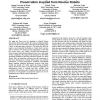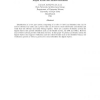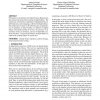JUCS
2008
14 years 6 months ago
2008
: During the last decades, digital objects have become the primary medium to create, shape, and exchange information. However, in contrast to analog objects such as books that dire...
CCIA
2009
Springer
14 years 7 months ago
2009
Springer
1 We adapt the Shout and Act algorithm to Digital Objects Preservation where agents explore file systems looking for digital objects to be preserved (victims). When they find somet...
DELOS
2007
14 years 7 months ago
2007
Digital preservation has turned into a pressing challenge for institutions having the obligation to preserve digital objects over years. A range of tools exist today to support th...
ERCIMDL
2000
Springer
14 years 9 months ago
2000
Springer
An Archival Repository reliably stores digital objects for long periods of time (decades or centuries). The archival nature of the system requires new techniques for storing, inde...
DRM
2006
Springer
14 years 9 months ago
2006
Springer
Identification is a two part system comprising of a token or label (an identifier) that can be used to reference an entity and a process that can be used to create label-entity as...
DL
1998
Springer
14 years 10 months ago
1998
Springer
We propose an architecture for Digital Library Repositories that assures long-term archival storage of digital objects. The architecture is formed by a federation of independent b...
MSS
1999
IEEE
14 years 10 months ago
1999
IEEE
The supercomputer center, digital library, and archival storage communities have common persistent archival storage requirements. Each of these communities is building software in...
ICICS
2001
Springer
14 years 10 months ago
2001
Springer
Abstract. In electronic commerce, traded digital objects are likely associated with several numerical values as well as their prices. These values may change unpredictably over tim...
JCDL
2004
ACM
14 years 11 months ago
2004
ACM
This paper describes a Web-services-based system which we have developed to enable organizations to semi-automatically preserve their digital collections by dynamically discoverin...
HT
2005
ACM
14 years 11 months ago
2005
ACM
We describe the integration of smart digital objects with Hebbian learning to create a distributed, real-time, scalable approach to adapting to a community's preferences. We ...





